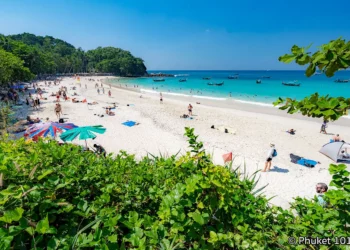Located in Hyderabad, Telangana, Chilkur Balaji Temple is an ancient Hindu temple dedicated to Lord Venkateswara, a form of Lord Vishnu, often called Balaji. Set near Osman Sagar Lake, some 25 km from Hyderabad’s heart, it’s known as the “Visa Balaji Temple” because devotees believe prayers and worship here aid in getting travel visas making it very famous among the locals and even people throughout the country.
Historical Overview
The temple goes back to the 14th century CE, though village talk hints at older roots. In Chilkur village, it likely took shape under the Kakatiya kings’ sway. Old tales say a man named Akkanna stumbled on Venkateswara’s idol in a forest and raised a small shrine. The temple grew bigger in the 1900s, thanks to the Madhava family, priests who set its ways.
By the 1980s, it got called “Visa Balaji” when young people and workers said prayers here helped them get visas. Unlike most temples, it’s run by the priests’ family, not a state board. Fixes in the 1990s, like a new tower in 1995, kept it solid. This past shows local faith and hard work, making the temple a dear spot.
Mythological Importance
The temple is for Lord Venkateswara, said to bring wealth and make wishes come true. Called the “Balaji of everyday folks,” it’s small version of the Tirupati Balaji Temple. The murti, cut from black stone, shows Venkateswara with Sridevi and Bhudevi, tied to riches and the earth.
A village story says a farmer, Venkataiah, dreamt Venkateswara told him to dig up the idol hidden in Chilkur’s woods. He found it, built a shrine, and the deity gave his assurance to answer prayers fast, especially for those in a fix. This tale pulls in people needing help with visas, jobs, or weddings, giving the temple its name for granting wishes.
Local Stories and Traditions
A well-loved tale is about Gopal, a student in the 1980s, who couldn’t get a U.S. visa. He prayed here and promised to walk around the sanctum 108 times. His visa came, making the “Visa Balaji” tag popular. Now, people do 11 pradakshinas (circles) to ask for a wish and 108 when the wish is fulfilled, a tradition only seen here.
Another story tells of Lakshmamma, a woman in the 1800s, healed from sickness after praying at the temple. She gave a bell, still rung at festivals. Her kin visit each year, binding them to the shrine. A quieter tale speaks of a carpenter, Narayana, who, in the 1900s, carved a wooden lamp for Balaji after his missing daughter came home. Villagers also tell of a childless pair who, after praying here, had a son and started tying palm leaves near Sridevi’s shrine for others to have kids. These stories, shared by locals, keep the temple’s past alive.
Locals hold fast to old traditions. Students leave pens by the murti for exam luck, a trick from parents. Newlyweds tie coconut shells near Bhudevi’s shrine for a good marriage, learned from elders. At festivals, families hand out tamarind rice to guests, keeping a promise from a rich harvest. These customs show the temple’s big part in village life.
Temple Structure and Design
The temple follows a plain South Indian Dravidian style, right for its village setting. The main tower, raised in 1995, has stone carvings of Vishnu’s lives. The sanctum holds black-stone idols of Venkateswara, Sridevi, and Bhudevi, decked with flowers and silver. The vimana, a stepped roof over the sanctum, is white-painted for purity. Small shrines for Garuda, Hanuman, and Andal sit inside. The temple’s on a hill by Osman Sagar Lake, with stone paths for pradakshinas. Tamarind trees round it give a quiet feel. The build is open, letting folks circle easy, showing its heart is prayer.
Rituals and Festivals
The temple throws big festivals. Brahmotsavam in September or October, a nine-day affair, has marches and homams (fire rituals). Vaikuntha Ekadashi in December or January pulls folks for spiritual gain. Vijayadashami marks Vishnu’s win. Daily worship covers Suprabhata Seva (morning prayers), Archana (offerings), and Aarti (lamp ritual). Pradakshinas are the main act, with no paid sevas, keeping it fair for all. The website, chilkurbalaji.org, posts festival times and takes online prayers. Free laddus come as prasad, like at Tirupati. A special ritual, Sankalpa Seva, has folks say their wish before circling, thought to call Balaji’s aid. Tulasi Puja, giving basil garlands on Saturdays, is for riches. These keep the temple’s fire burning.
Information for Travelers
Hours and Entry: Open daily, 5:00 AM to 8:00 PM. Entry and rituals are free. Seeing the idol takes 20–30 minutes; circling and looking round take 1–2 hours.
Clothing: Wear simple clothes. No strict rules, but traditional dress is favored.
How to Get There:
Air: Hyderabad’s Rajiv Gandhi Airport, 35 km off, is closest. Taxis or buses hit Chilkur.
Train: Hyderabad Railway Station, 30 km away, ties to major towns. Buses or autos get to Chilkur.
Road: Chilkur’s 25 km from Hyderabad’s core. Buses and cabs go often from Secunderabad and Koti.
Best Time to Visit:
October to March has good weather. Weekdays are calm. Godavari Pushkaralu, every 12 years, brings crowds—next in 2027.
Historical and Cultural Details
The land where the temple is built is called a sage’s prayer ground in old stories, also per Vishnu Purana. Kakatiya kings likely helped early shrines, per 14th-century marks. Locals stick to old habits. Farmers give first grains to Balaji for strong crops, whereas, students tie threads by the idol for sharp minds. At Brahmotsavam, folks light lamps on paths, holding a promise from a plague’s end.
A custom is Venkateswara Namam, dabbing a tilak on foreheads daily for safety. Pavitrotsavam, a cleansing ritual in August, links to a merchant’s thanks for a safe road. Locals say walking round the tamarind tree by the temple brings smarts, a belief from old folks. These bits make Chilkur shine.











